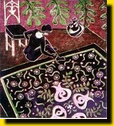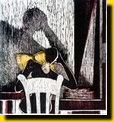Impressed Dimensions : The Art of Printmaking
Thematic Gallery (3) & (4),
Hong Kong Heritage Museum
18 May 2001 - 31 August 2001
Have you ever imagined that a photocopier or a computer can make art? With the advancing technology, printing is no longer confined to the traditional printing plate. The exhibition features about 50 print works made by various local artists between 1950s to present in 4 themes, showcasing the multifarious facades of the printing medium in its application to art. The works featured also mirror the changing social and cultural landscape of Hong Kong over the years, revealing the textual dimensions of the art form. A video series of artists' demonstration enhanced visitors' appreciation of the art and you will have a chance to make you own print.
Exhibit Highlights
The City - Landscape, Space, Home
Prints of different period are mirrors of their respective time. They are also artists' subjective, personal record of their experiences in regard to the locality, the space and the changes of Hong Kong over the years. How artists visualize and understand the city echo our own perceptions in many ways.
|
|
 |
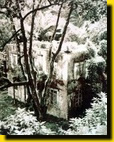 |
Shatin #1
Fung Ho-yin
1995
New media printing – Gum print
51(H) x 41.5(W) cm
Hong Kong Heritage Museum collection
Fung Ho-yin is enamored with local sceneries which fascinated him with their richness in lines and textures. A hut in Shatin drew his attention while he was walking from Pai Tau Village to the Temple of Ten Thousand Buddhas. Fung captured the sunlit hut with his camera and transformed it into the work "Shatin#1"
|
|
 |
 |
My Home at Dusk
Ng Yuen-wa
1996
Planography – Lithograph
106(H) x 168(W) cm
Hong Kong Heritage Museum collection
Ng Yuen-wa seeks inspiration in the minor details of life, creating prints with as much passion for the art as for life. "My Home at Dusk" was inspired by scenes in Hong Kong Mid-Levels. To give a more vivid representation of the ideal home, Ng goes behind the walls and reveals people's activities inside the house: playing piano, sleeping...She breaks down the usual constraints of perspective and evokes an aspiration for simple life and warmth of home.
|
 |
|
 |
 |
 |
Cage
Chan Kam-shing
1998
Serigraphy – Silkscreen
38(H) x 63(W) cm
Hong Kong Heritage Museum collection
"Cage" is a down-to-earth depiction of some of the gloomiest of Hong Kong's dwellings - the "Cage houses". Chan Kam-shing shows his sympathy for the "Cageman" in a somewhat tongue-in-cheek manner. While lamenting the misfortune of the "Cageman", Chan depicts their miserable living space as a tiny kingdom and dreams. Self-consolation is but a survival strategy to defeat social despair.
|
|
 |
 |
The Life - People, State of mind, Memory
Everyday life may appear uneventful, but if we take a closer look, our daily life can be quite colourful and varied. Social events, human relations are some of the essential constituents of our public life, whereas our minds and inner feelings determined our life experiences. Prints in this section would tell us how life made its impression on the artists.
|
|
 |
|
|
Taking Rest, Study (top to bottom)
So King
1985-86
Relief printing – Woodcut
50.5(H) x 45(W) cm (top)
44.5(H) x 40.5(W) cm (bottom)
Hong Kong Heritage Museum collection
So King uses the chair as the subject of her meditation on life issues in this series of print. The chair is usually taken for granted as an object providing comfort and is often seen as banal. As people tend to overlook things around them, hence, by casting people's eye on the ordinary, So transforms banality and evokes people's deeper reflection on life.
|
|
 |
 |
Untitled
Liu Siu-jane, Jane
1986
Planography – Lithograph
90.5(H) x 35(W) cm
Hong Kong Museum of Art collection
Jane Liu's works are often metaphorical, they are allegories representing personal thoughts and feelings. "Untitled" depicts ants and silkworm pupa as an allegory of human society and interpersonal relationships. For Liu, the ant community is a statement that an individual is not considered a life, but a group is.
|
 |
|
 |
 |
|
|
Romance of Imperial Capital I, II, III & VII
(top to bottom)
Wong Kui-hung, Ben
1987
Relief printing – Water-based woodblock printing
20.5(H) x 28.5(W) cm (each)
Hong Kong Heritage Museum collection
The "Romance of Imperial Capital" series was completed soon after Ben Wong graduated from university. Seeing that many people succumbed to material pleasures promised by the prosperous times, Wong retreated to self-reflection on the true meaning of life. In lamenting life's shortness, he wanted to use his works to alert people to the ills of material indulgence and decadence.
|
|
 |
 |
The Tradition - Heritage, Symbol, Identity
Hong Kong has long been under the influence of the Chinese cultural traditions – in customs, beliefs as well as in arts. At the time when searching for one's roots was the rage, Chinese cultural identity was fervently sought after. The notion of cultural heritage and modernity also has its impact on artistic development as evident in the art prints.
|
|
 |
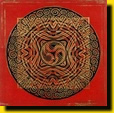 |
Season in Red
Van Lau
1970
Intaglio – Etching
45.5(H) x 45.5(W) cm
Hong Kong Heritage Museum collection
"Season in Red" recalls the social and cultural background of its time. Around 1967, the search for Chinese cultural identity was pursued with enthusiasm by the Chinese intellectuals overseas as well as in Hong Kong. There was a movement advocating the revival of Chinese culture and the study of the traditional heritage. Van Lau was involved with this movement, and the work was a personal response to his time.
|
|
 |
 |
Noise, Noise, Noise
Jerry Kwan
1972
Relief printing – Water-based woodblock printing
75(H) x 52(W) cm
Hong Kong Museum of Art collection
In 1960s, modernist movement and abstract art, reigned in Europe and the U.S., were introduced to the Hong Kong art scene. A group of young avant-garde artists, Jerry Kwan being one of them, were inspired by these trends and began to incorporate such concepts into traditional Chinese paintings, aiming at developing a new art form with both the Western modernist and the traditional Chinese characteristics. "Noise, Noise, Noise" is exemplary of such an experimental spirit.
|
 |
|
 |
 |
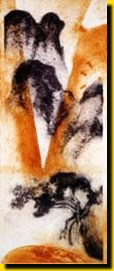 |
Heaven and Earth VI
Lau Shuk-fan
1991
Mixed media printing - Collagraph & mixed media
90.5(H) x 37(W) cm
Hong Kong Heritage Museum collection
Lau Shuk-fan's "Heaven and Earth VI" visualized Hong Kong in the Chinese landscape format. Manipulating the brushstrokes and the texture of the acrylic medium on fibreboards, Lau replaces the Chinese ink and brush with contemporary materials. Probably out of subconsciousness, images like flowers and birds, landscape and trees symbolic of the Chinese painting tradition frequently appear in Lau's works.
|
|
 |
 |
The Art - Concept, Aesthetics, Techniques
Printmaking is a unique art form in the sense that it has artistic qualities that are not shared by other art media. Many artists are attracted by its distinctive appeal and explore its possibilities ?visually, conceptually and technically. The artists' experiments showcase creative potentials of the medium as well as of their own.
|
|
 |
 |
Layering
Choi Yan-chi
1983
Serigraphy – Silkscreen
41.5(H) x 47.9(W) cm
Artist's collection
The printing medium is for Choi Yan-chi an experimental field for artistic exploration. "Layering" is an experimental piece that explores the body of ink and the extension of the pictorial space. The composition of the picture and texture constitute the subject of the work.
|
|
 |
 |
Magic Eye
Ha Bik-chuen
1984
Mixed media printing – Collagraph & gouache
61(H) x 80(W) cm
Hong Kong Heritage Museum collection
Inspired by a news broadcast, Ha Bik-chuen came up with the whimsical vision of a satellite-like eye in outer space observing the world, exploring the mysteries of the universe. With a rich array of materials, this print presents a unique and futuristic invention by Ha.
|
 |
|
 |
 |
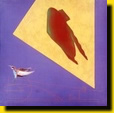 |
Fantasist
Lau Kwok-fai
1994
Serigraphy – Silkscreen on canvas (mono print)
106(H) x 106(W) cm
Artist's collection
Lau Kwok-fai creates a virtual object and a "real" bird by means of digital manipulation and silkscreen printing, juxtaposing illusionary and realistic spatial dimensions. The sharply intersecting planes of the virtual flying object and the bird suggest situations where individual freedom is being intruded. Or, it can also be an allegory to the contrasting realms of personal dreams and reality.
|
|
 |
 |
Other Past Exhibitions
|



